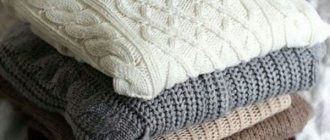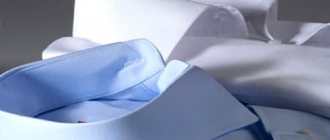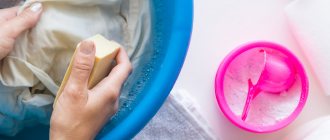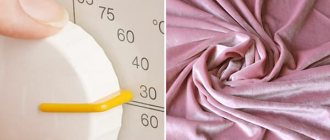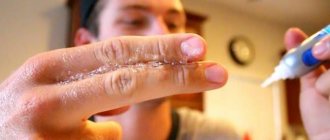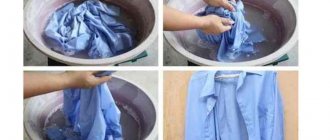Scarves, hats, blouses, socks - all these things can not only be bought, but also knitted with your own hands, just like flirty summer hats or beautiful lace napkins.
But it’s not enough to act exactly according to the pattern; you need to starch knitted items, give them the correct shape, and then process them regularly in order to maintain an attractive and neat appearance for as long as possible. Housewives have several proven methods for this.
What things are better not to starch?
When things are starched, a film forms on their surface, which provides a rigid shape, prevents curling of the edges, and evens out the pattern. There are many positive qualities, but there are still cases when using starch is not only useless, but also harmful:
- after processing, ugly whitish stains will most likely appear on dark things, so in this case it is better to look for another option;
- You should not starch things that should remain breathable, that is, allow air to pass freely, since the film formed afterwards is absolutely airtight;
- starching synthetic products is a pointless exercise, since the process has no effect on threads of such composition.
We use gelatin
Another way to stiffen things up is to try gelatin.
The gelatin method is ideal for dark items - it does not leave marks on the product. And also very easy to wash.
The gelatin solution is prepared as follows:
- Soak 1 tablespoon of gelatin in a small amount of water.
- After the gelatin swells, add water to the volume of one glass.
- Heat the resulting mixture until the gelatin is completely dissolved.
We also lower the product into the resulting solution, wait a little, squeeze it out, straighten it and dry it.
Classic - starch
There are several types of starch, but statistically, potato starch is more popular for processing things than corn or rice. This is the most affordable option and is easy to find on sale. Basically, two methods are used: hot and cold.
Hot way
The proportions of the solution are selected depending on the required level of starching:
- for soft – 1 tbsp is enough. l. powder per 1 liter of water;
- for medium – 1.5 tbsp. l. for 1 liter of water;
- for hard – 2-2.5 tbsp. l. for 1 liter of water.
Preparatory steps:
- First you need to prepare a starch solution by mixing the required amount of starch with a glass of cool water. Mix the mixture thoroughly until smooth and without lumps.
- Next, heat the water in a large container (so that the item being processed fits there entirely).
- As soon as it boils, pour in the pre-prepared starch concentrate in a thin stream, stirring the water constantly. And if you add a pinch of salt, the processed products will acquire a beautiful shine.
- As soon as the water boils again, turn off the stove. After waiting for the liquid to cool, begin the process.
Now you can starch your knitted product:
- Soak the selected item completely so that all edges and corners are in the water. Leave for 5 – 15 minutes. The duration of soaking depends on the thickness of the threads (the thicker they are, the longer they last).
- Then take out the item and let the liquid drain.
- Squeeze it lightly, spread it on a table or other flat surface (or on a blank of a suitable size), carefully straightening it and giving it the desired shape. To be sure, you can secure the product with pins.
Another technique suitable for small items or individual parts. Place the pre-moistened product on a thick cloth spread out and use a brush (a wide paint brush is perfect) to treat it with a starch solution.
For delicate processing, use the spraying method, pouring a weakly concentrated solution into a spray bottle.
Cold way
A method that does not involve heating the solution is best suited for mild starching.
Mix starch and cold water thoroughly to a smooth, homogeneous consistency. Immerse things in the resulting mixture for half an hour. Having taken them out, they must be carefully squeezed out and fixed on a flat surface or a special workpiece (if the item is voluminous).
There are other ways to give knitted items shape and stiffness.
Note to the needlewoman
If you decide to starch your favorite knitted (and other) items, then these useful tips will be in your favor:
- If liquid gets on a product that has been starched, the procedure will have to be done again;
- You need to dry things carefully. If you iron them wet, all the snow-white parts may turn yellowish;
- You should not send freshly starched items to damp places for storage - they can “acquire” mold, which will simply destroy the item;
- If the mixture is not very clean, but has turned gray or yellowed, then before work it must be thoroughly mixed until the dirty layer disappears;
- When using sugar syrup for starching, remember that such a thing can become an “object” of attention of various insects;
- In order for the product to “stand” after starching, you need to prepare the thickest possible solution, then stretch the product onto a strong frame and dry it in the sun or in a warm place;
- If any elements stick together on the product after starching, you can simply hold them over a boiling kettle for a couple of minutes, and then “comb” them with a comb;
- To prevent starched items from sticking to the iron during ironing, starch should be made with milk rather than boiled water;
- To speed up the process as much as possible, the product soaked in the solution should be placed in the microwave for a couple of minutes, setting the maximum power, then squeezed out, and sent to dry. Starching with this method is carried out more efficiently.
A few words about drying
It is worth considering one important point - starched items should not be exposed to frost, since at low temperatures the starch can turn into sugar and become sticky.
All starched items must be placed on a dry, clean white cloth and sent to a well-ventilated area, waiting until completely dry. You can also use a regular towel - pin the product to it with pins.
Starchy, damp items can also be ironed by placing a clean, thin cloth on the item and setting the temperature to the minimum setting. But this must be done extremely carefully.
Follow these simple instructions and recommendations, and all your knitted items will be elegant and very beautiful.
How do you like the article?
Sugar
As the saturated sugar syrup hardens, it becomes dense. This property is used to give rigidity to things. There are two recipes for preparing the composition.
For the first one, mix 1 glass of water and 2 glasses of sugar. Stirring constantly, heat in a water bath until thickened. Cool at room temperature, then apply to the item.
For the second option you will need:
- 3 tbsp. l. Sahara;
- 1 tsp. starch;
- 100 ml water.
We act step by step:
- Mix the starch with a few tablespoons of cold water (taken from the total volume) until it becomes a liquid paste.
- Mix the remaining water with sugar and heat.
- Then pour both mixtures into one container and heat over low heat, stirring all the time, until the mass thickens and bubbles begin to appear at the edges.
- After this, you need to wait until the mixture cools down. And then you can either soak the item in it for 10 - 15 minutes, or treat it with a brush, applying the required number of layers.
This method has one drawback - sugar attracts sweet-loving insects.
Why is the treatment carried out?
Starch is a crystalline powder that is obtained from grains and tubers. Many cooks know starch from potatoes. Flour is also made from corn, rice, and wheat. Potato starch is usually used for starching - it is cheaper than rice and white, unlike corn flour.
Under the influence of water, the crystals swell, which contributes to the preparation of the paste. After the moisture evaporates, natural glue seizes the fabric fibers. Accordingly, the more starch, the stiffer the fabric will be. Craftswomen often resort to the starching procedure to fix the product according to their creative idea. In addition, processing with starch makes the item more practical:
- prevents creasing;
- makes ironing easier;
- traps dust and dirt;
- Remains snow-white for a long time.
Starch acts as a bleaching agent. If there are scuffs and stains on the threads during knitting, starching will give the finished product a neat appearance.
PVA or silicate glue
These products are great for maintaining the shape of knitted napkins, vases, and hats. They do not leave streaks and dissolve easily in water.
PVA glue is diluted, choosing the proportion depending on the desired hardness. Usually the components are mixed in equal parts or take twice as much water as glue.
The product is soaked in the solution, treated with a sprayer or brush, and then dried at room temperature, spread out on a table or a special form.
The technology with silicate glue repeats the method using PVA. But the proportions for preparing the solution are different - for 5 liters of water you will need only 1 tsp. such glue.
What is starch used for?
Things crocheted or knitted starch. This could be, for example, napkins, tablecloths, and various kinds of crafts. In addition, men's shirts, medical workers' gowns, chefs' hats and some other types of clothing are subjected to this type of treatment.
But it is worth remembering that not all things are starched. The following items do not starch:
- made of black threads (white stains may remain);
- knitted from synthetics;
- underwear (the fabric stops allowing air to pass through).
Small tricks
With the help of recommendations, you can easily correct an unsuccessful area or give shape to non-standard things.
- If during the process of drying a starched item it turns out that the shape needs to be corrected, the defective area is heated over steam, then fixed in the desired position and dried.
- To give a knitted hat the desired shape, it is put on an object that is most suitable in shape and size, for example, a ball or a can. If there are brims, then a hole is cut in the cardboard box to the size of the item on which the hat is dried, and the brims are laid out throughout the box.
- To dry a knitted vase with a narrow neck and at the same time maintain its shape, dry beans are poured inside. Once the vase is dry, the beans can be easily poured out.
- To preserve the shape of the openwork napkin, before starching, lay it out on a sheet of paper and trace along the contour of the pattern with a pencil. After processing, the napkin is combined with the pattern and secured with pins.
Having no experience in starching knitted items, it is advisable to first try your hand at something not very valuable. This way you can not only fill your hand, but also clarify the proportions, which greatly depend on the composition and quality of the material, as well as the characteristics of the ingredients used.
Tips for drying and ironing
After soaking the napkin in starch or other solution, it must be laid out on a flat surface. For example, you can place it on an ironing board with a terry towel on it. If glue was used, then the fabric should be covered with cling film.
It is advisable to secure the edges of the product with pins so that it holds its shape. All patterns should be straightened and fixed while the napkin is wet. If there is fringe on it, it needs to be combed and laid out evenly.
It is better to dry the product not in direct sunlight, but in a ventilated room. A slightly damp cloth needs to be ironed with a warm iron through several layers of gauze. It is important to act quickly, but carefully so that the edges do not wrinkle. The iron should not be too hot, otherwise the threads will turn yellow.
If you need to make a vase or plate from a knitted napkin, you should take a base for giving the shape - a bowl, glass, bottle. Cover the outside of the item with cling film. Place a damp napkin soaked in starch (gelatin, glue, sugar) over it and leave until completely dry. This may take up to 24 hours.
Knitted napkins and various decorative items made from them are a classic interior decoration. Handicraftsmen spend a lot of time and effort creating such products. Treatment with starch or other means is an important final step to give the textiles a shape and a neat appearance. The effect lasts until the first wash. It is not recommended to starch synthetics, wool, silk, floss and dark items.
Solutions used for starching
To starch a thing, in addition to the traditional and familiar starch, other solutions are also used. It can be:
- Starch (potato, rice, corn);
- Sugar syrup;
- Gelatin;
- Milk;
- PVA glue;
- Gloss-starch.

